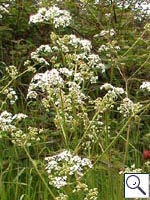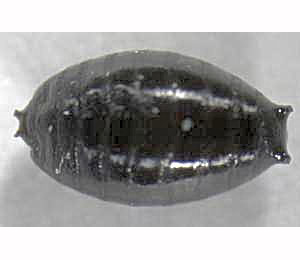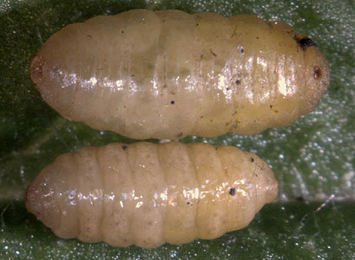|
||||||
|
ANTHRISCUS. Chervils and Cow Parsley. [Apiaceae] |
|
|
Two species of Anthriscus - Bur Chervil (A. caucalis) and Cow Parsley (A. sylvestris) - are native to Britain. A third species has been introduced - Garden Chervil (A. cerefolium). Five British miners are recorded on Anthriscus. A key to the European miners recorded on Anthriscus is provided in Bladmineerders van Europa. |
 Cow Parsley Anthriscus sylvestris |
Key for the identification of the known mines of British |
|
1a > Leaf-miner: Oviposition as a rule in the stem, only occasionally in a leaf. In the latter case the larva makes an upper-surface corridor that ends in a thick vein. From there it descends, through petiole and stem, down to the root. Here the pupation takes place (Spencer, 1990: 163). |
|
|
|
Napomyza carotae Spencer, 1966 [Diptera: Agromyzidae]. |
|
1b > Leaf-miner: A short, narrow, linear mine, generally closely following margin of leaf segment; in very small sections of a leaf producing a secondary blotch (Spencer, 1972b: 89 (fig. 302), 92; Spencer, 1976: 401 (fig. 702), 402). Upper-surface corridor, in the end widening so strongly that within the limited space of an umbelliferous leaf often a secondary blotch is the result. The upper-surface mine is preceded by a short lower-surface corridor, made by the first instar larva during the first part of this stage (Allen, 1956a). It is difficult to observe, also because it tends to follow the leaf margin. Frass in two untidy rows of isolated grains. Before pupation the larva leaves the mine through a semicircular exit slit in the lower epidermis. A narrow mine, follows leaf marginand forms secondary blotches. |
|
 Phytomyza chaerophylli puparium Image: © Willem Ellis (Bladmineerders van Europa) |
|
|
|
Phytomyza chaerophylli Kaltenbach, 1856 [Diptera: Agromyzidae]. |
|
1c > Leaf-miner: Young larvae make small, full depth blotch mines, almost without frass. Older larva live externally on the plant under a light web. Initially forms a small blotch mine and may later feed in a slight web. In coastal areas may continue mining throughout the larval stage. |
|
| On Carex, Agrostis, Anthoxanthum, Deschampsia, Festuca, Holcus and Poa in Britain plus Phalaris elsewhere. Widespread in Britain, Ireland and continental Europe. | |
|
Epermenia aequidentellus (O. Hofmann, 1867) [Lepidoptera: Epermeniidae]. |
|
1c > Leaf-miner: The larvae are often gregarious and feed on the underside of the leaf causing a 'windowing' effect as they eat the mesophyll and lower epidermis. This effect can be seen from the top of the leaf as it discolours. Short, small, irregular, sometimes widened corridor. Mostly a number in a leaf, concentrated in the axils of the midrib and the primary side veins. Each larva makes a number of mines. Often the larva protrudes with its rear end out of the mine, causing most frass to be ejected. While moving, at the leaf underside, silken threads are produced, in wich grains of frass may be trapped. Older larvae live free and cause window feeding, often in a group under a light spinning. |
|
|
|
Epermenia chaerophyllella (Goeze, 1783) [Lepidoptera: Epermeniidae]. |
|
1d > Leaf-miner: A large blotch, yellow or brown, preceded by a short corridor that in the end mostly is completely overrun. Generally several larvae share a mine. Especially in fresh mines the green primary and secondary feeding lines are well visible. Pupation outside the mine. Puparium yellow. |
|
 Euleia heraclei pupariria Image: © Willem Ellis (Bladmineerders van Europa) |
|
|
|
Euleia heraclei (Linnaeus, 1758) [Diptera: Tephritidae]. |
|
| Last updated 30-Jun-2019 Brian Pitkin | ||
